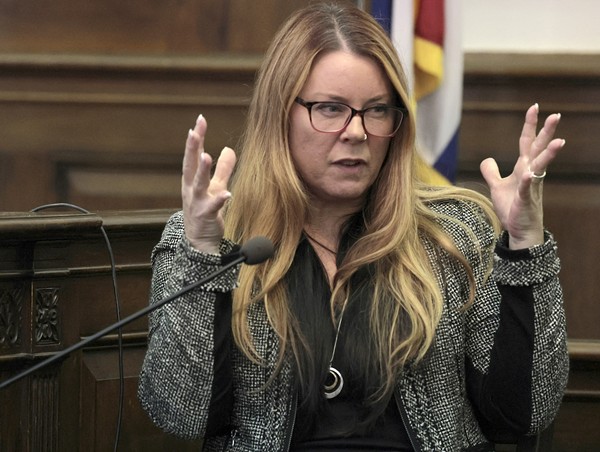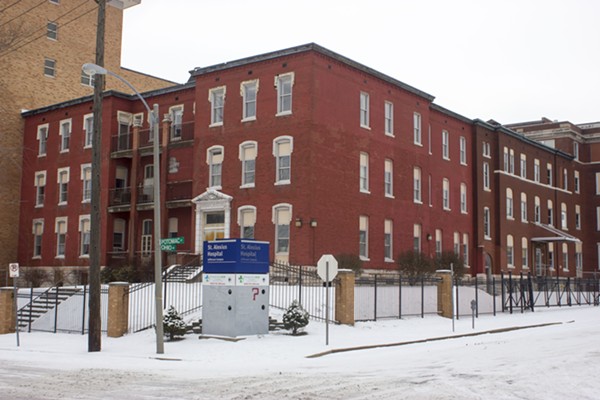Local News
Accused Cop Killer Suffered Serious Abuse, Expert Tells Jury

An accused cop killer currently on trial in St. Louis endured years of childhood abuse at the hands of both parents, an upbringing that a forensic psychologist says ultimately led to the August 2020 psychotic episode in which Thomas Kinworthy killed St. Louis police officer Tamarris Bohannon.
The prosecution and defense agree on the basic facts of the case. On August 29, 2020, Kinworthy was armed when he ran into a house on Hartford Street in Tower Grove South. The home’s two residents fled out the back door and called the police. Bohannon, a St. Louis Metropolitan Police Department officer, responded to the scene, where Kinworthy opened fire on him and killed him as he approached the front door. After a 12-hour standoff, Kinworthy was taken into custody and charged with murder.
Kinworthy’s attorneys are pursuing a not guilty by reason of insanity defense, arguing that Kinworthy couldn’t understand what he was doing was wrong when he killed the 29-year-old father of three.
That strategy depends in large part on the testimony of forensic psychologist Patricia Zapf, who first took the stand yesterday and said that Kinworthy meets the standard for being not guilty by reason of insanity.
She testified today that she’d reached this conclusion because Kinworthy was in an “acute psychotic episode” and “disconnected from reality” on August 29, 2020.
Zapf testified she has extensively interviewed Kinworthy, his father, ex-wife and others. The picture those interviews painted of Kinworthy’s life leading up to the killing of Bohannon is grim, including a history of extensive mental, physical and sexual abuse perpetrated by both parents.
Kinworthy was directly molested by his mother, Zapf said, and as a child was made by both parents to perform sexual acts on other adults at various times in his adolescence. She added that Kinworthy’s parents were both very involved in drug culture, with both mom and dad using crack cocaine.
At one point, his parents split, with his mother moving to Florida and Kinworthy staying in St. Louis with his father.
His father beat him and “verbally degraded him,” Zapf said, saying that even when she interviewed Kinworthy’s dad, he told Zapf his son never did anything right.
click to enlarge POOL PHOTO / ST. LOUIS POST-DISPATCH Forensic psychologist Patricia Zapf testified in court today that Thomas Kinworthy suffered years of sexual abuse from both parents and has heard voices since he was a pre-teen.
Zapf also said that at one point, as the pre-teen Kinworthy was living with his father here, his mother kidnapped him and took him to Florida.
In Florida, Kinworthy’s life was even worse than in St. Louis. Life with his mother was “unstable and impoverished,” and she trained him to steal things from stores. There was significant sexual abuse in Florida, Zapf said, with his mother forcing him to have sex with various adults.
It was around this time, in Kinworthy’s pre-teen years, that he began hearing voices and lighting fires, said Zapf.
Around the age of 14, Kinworthy came back to live with his father in St. Louis, where he stayed in a flop house, smoked crack with his dad and was again subject sexual abuse by people passing through to buy and sell drugs.
Zapf testified that there was a history of mental ailments on both sides of Kinworthy’s family and that the severe stressors added throughout years of abuse would have exacerbated his underlying disposition to mental illness. In her opening statement on Monday, Kinworthy’s attorney said that he has been diagnosed with schizoaffective disorder and has heard voices much of his adult life.
As an adult, Zapf said, Kinworthy would slip into manic states, not sleeping for days and having indiscriminate sexual encounters with numerous partners.
In 2006, Kinworthy’s dad was charged federally as part of a conspiracy to distribute methamphetamine. He was initially sentenced to almost 20 years, but was released early, according to court records.
Five days before he would kill Officer Bohannon, in August 2020, Kinworthy, then 43, came to St. Louis to reconnect with his father. Over the next several days, Kinworthy met with dad for about an hour a day. His dad later told Zapf he “recognized something was off” about his son but didn’t confront his son about his unusual behavior.
On the day of the shooting, Zapf said Kinworthy was in a “sexual frenzy state,” had a sexual encounter with a man near Tower Grove Park, and then Facetimed his ex-wife from the park. During that call, he was hiding behind a tree, “white as a ghost” and professing that he believed people were out to get him.
Kinworthy would soon call his ex-wife back after he was barricaded in the Hartford house after killing Bohannon. Zapf testified that the ex-wife found the conversation largely incoherent, but understood Kinworthy to be saying goodbye.
Prosecutor Mary Pat Carl only had about half an hour to question Zapf today before proceedings were called to a halt for the weekend break. However, even in that relatively brief period, the jury got a sense of what the prosecution’s strategy is likely to be regarding Zapf’s expertise.
Carl called to the jury’s attention that Zapf had billed $27,000 to Kinworthy’s defense for her time working for them.
Carl also argued that the process by which Zapf wrote her report about Kinworthy was in contradiction to the process Zapf laid out as a best practice in her own book, specifically that an expert compiling a report on a defendant’s state of mind should have “all the information” before telling the defense what conclusions that report will contain. Carl implied that Zapf had already decided on the basic conclusions of the report before she conducted several “collateral” interviews of Kinworthy’s family members.
Right before the end of today’s proceedings, Carl alluded to jailhouse phone calls during which Kinworthy’s ex-wife and Kinworthy encouraged their child to Facetime Kinworthy’s father.
“Wouldn’t it be good to know whether or not the man they are claiming did horrible abuse and traumatized the defendant is someone they’re also encouraging their daughter to have a relationship with?” Carl asked Zapf. “That wouldn’t weigh in on their credibility at all?”
Zapf said she wasn’t aware of the jailhouse calls.
Kinworthy’s trial is set to resume Monday morning with Carl’s continued questioning of Zapf.
Subscribe to Riverfront Times newsletters.Follow us: Apple News | Google News | NewsBreak | Reddit | Instagram | Facebook | Twitter | Or sign up for our RSS Feed
Local News
St. Louis’ Juvenile Justice System Is Failing Youth and Families

This story was commissioned by the River City Journalism Fund
Ta’janette Sconyers, a psychologist hired to work with youth at the St. Louis Juvenile Detention Center, found herself grappling with her own anxiety and despair over conditions inside the facility. It got so bad that she took a leave to protect her mental health.
Finally, in 2019, she simply resigned, becoming part of the turnover at the detention center, which seemed to do so little to provide youth with treatment, rehabilitation or even sunshine and fresh air.
“They said it was a revolving door. But I always asked, did anyone ever take the time to figure out why the door kept revolving,” says Sconyers.
Sconyers specializes in treating the effects of anxiety, trauma and OCD, and those were also some of the issues she diagnosed and treated while working at the St. Louis Juvenile Detention Center on Enright Avenue. It’s one of 18 juvenile detention centers in Missouri operated by the circuit courts that hold minors accused of crimes and deemed threats to public safety. Administrators say rehabilitation and treatment are the goals for the approximately 2,000 youth in the state who funnel in and out of the detention centers annually.
If a youth is found guilty of a crime, the courts can commit them to a more permanent secure facility operated by the state’s Division of Youth Services, which has about 20 residential facilities and housed more than 1,200 youth last year. Youth can also end up at state facilities if they are repeatedly caught committing crimes. While legal terminology refrains from referring to these institutions as youth jails and prisons, they are still forms of incarceration, Sconyers points out.
Many of the youth never spoke to her, although some would check to make sure she was around every day. Others would open up to her about why they made the decision they did — money and a dissociation from their actions, she says.
But Sconyers ultimately concluded that her attempts to make a difference were futile.
“I felt I had more of a chance of helping them by not being a part of the system,” says Sconyers, who resigned from the facility in 2019 and is now in private practice. “If people’s basic needs aren’t being met, how do you think I’m going to be able to sufficiently address their trauma?”
A series of escapes in recent years has changed the policies at St. Louis area detention centers. It’s one reason why St. Louis area facilities, most which have outside recreational areas, have stopped allowing detained youth to use them. Amanda Sodomka, who led the city’s juvenile detention center as chief juvenile officer for the 22nd Circuit Court until a recent promotion, says the city’s juvenile facility is working on upgrades to the doors and a higher fence in order to consider allowing youth outside again.
“We have very smart youth,” says Sodomka. “It poses enough risk, we just can’t have them outside right now.”
Yet Sconyers says the lack of fresh air was one of many things that disturbed her. Some youth were only there for days, but others for months or years as their cases played out. She and other staffers attempted multiple times to organize letting youth go out for even a few minutes each day, but those efforts were always shot down.
And that was even before her facility saw an unprecedented number of escapes, as did many other St. Louis area detention facilities. Juvenile administrators and staff point to the recent “Raise the Age” state law that requires 17-year-olds not to be tried as adults, which went into effect in 2021. Data from the Missouri Supreme Court confirms most of the escapes from the juvenile detention facilities were from youth just a year shy of being legal adults.
News reports about the system’s failures, like escapes, can spark outrage and prompt reactive policies, says Gina Vincent, a juvenile justice expert who also co-directs the law and psychiatry program as a professor at the University of Massachusetts Chan Medical School.
“Judges aren’t paying attention to what works to rehabilitate juveniles, they’re paying attention to public perception,” says Vincent, who sees a concerning national trend. Lack of activities and more time in cells mean, she says, “You’re going to see an increase in aggression in facilities.”
For a system designed to provide rehabilitation, the juvenile justice framework has left many of the people who interact with it frustrated. Parents say they are left in limbo and often feel hopeless once their child is in the system. Some juvenile officers feel neglected by administrators and also say youth are given few resources to help them deal with their trauma.
For one youth who escaped and was recaptured, his accountability and rehabilitation process started once he received help outside of the system. Sconyers says those stories don’t have to be rare.
“It’s a powerful thing. It didn’t always happen for a lot of different reasons, but it’s possible,” says Sconyers. “People benefit from trauma work when it’s something they choose to do — when it’s something they have the capacity to do, when they are able to moderately engage with it, when it’s controllable for them, when it’s on their terms.”
click to enlarge THEO WELLING Karmahn Leach of Shine Bright Like a Diamond Youth Organization gives a presentation at New Spring Church. Leach hopes to mobilize parents to advocate for youth in juvenile detention — and themselves.
Inside the Juvenile System
The majority of youth who find themselves in the juvenile system are accused of misdemeanor offenses. That’s true both in Missouri and nationwide.
It’s the minority — those charged with felony offenses — who are typically brought to the court’s juvenile detention center. Their intake process mirrors jail, with a full strip search, shower and change of clothes. The brown, green or orange jumpsuits they are assigned are based on factors such as high risk or trauma.
Each new detainee then waits in a small room with a sliver of light beaming from a small rectangular prism. A metal frame, board, sheet and sink are all they have during the hours they are processed in.
After they are processed, the regimen begins. Calls are limited. Lunches are isolated: one youth to a table. While school is mandated, Sconyers says it often seemed to consist of students watching movies, a claim echoed by other officers.
But that’s not always the climate, says Amanda Williams, who runs day-to-day operations at the St. Louis Juvenile Detention Center as its superintendent. Youth have limited time out of their cells but are incentivized to earn more. The center has received multiple grants for arts and recreational activities, even if volunteers are sparse. Still, every day isn’t a crisis, she insists.
“Majority of the kids who come in here, they don’t give us a problem,” says Williams.
But some of the same juveniles cycle in and out of the detention center throughout their youth, says an officer at the St. Louis County Juvenile Detention Center who spoke under the condition of anonymity. “Simply because the detention center has never done anything to help these kids out,” the officer says.
Last fall, a group of parents whose children were incarcerated at the juvenile detention facility in Clayton banded together to demand better treatment of their children, transparency and an investigation into the facility. They said youth were forced to urinate and defecate on themselves or in containers they ate from because no one let them out of their cells in a timely way. They said fights were common and staff members turned to physical restraints to control the youth.
Other officers confirm some of the allegations, saying the safety and well-being of juveniles, as well as staff, are at risk.
The unnamed officer doesn’t sugarcoat the situation. He says officers are sometimes attacked by the youth detainees. “We’re not dealing with model citizens,” he says.
He says he remembers every youth who comes through the doors in Clayton. He tries to give them a realistic view of the situation they’re in.
But he says the system can’t help delinquent youth if it’s complacent with problems such as low morale in staff, bullying by administration and a lack of services, programs and activities for youth awaiting decisions on their criminal cases.
The people running the county’s juvenile system declined several requests for an interview. In an email, a spokesperson said, “Juvenile records are generally closed records, meaning they cannot be shared or discussed outside of court proceedings. … And for security purposes, St. Louis County Courts cannot comment on internal detention center policies and Human Resource matters.”
In the city, volunteers have come to talk to youth or help them write, play or teach yoga. But, the county officer says, the majority of the time the youth are just sitting.
“Playing cards and Uno is not going to do anything here,” he says.
While juvenile detention centers in Missouri are under the jurisdiction of the courts, putting them under the purview of the state, they are funded locally. Last fall, the St. Louis County Council leveled some of its only power over the courts and called for juvenile officials to attend a budgetary meeting. Juvenile administrators took the opportunity to request additional funding to address problems related to short staffing.
St. Louis County Councilman Ernie Trakas questioned county juvenile administrators about allegations of physical, verbal and sexual assault on youth by staff. But they denied knowing of any wrongdoing. He then wrote a letter asking Missouri Attorney General Andrew Bailey to investigate.
Bailey has not responded publicly to the request, and the St. Louis County Council has not addressed the issue since.
Officers at the county detention center have received new walkie-talkies and emergency buttons. But workers still face attacks by their young charges, and the administration often forces staff to work 16-hour shifts and tries to boost morale with gift cards, the officer says.
Even so, it’s hard to get staffers to speak up about systemic issues, the officer says. “You are talking about people that need to eat. They’re not going to push the envelope.”
Catch and Release
When a youth is arrested or detained by law enforcement in Missouri, a juvenile officer submits a referral to the court, similar to the warrant process for adults.
Referrals can result in a formal decision, which comes with either detention or intense supervision, such as GPS monitoring from the courts. The decision can also be informal, which might mean diversion-related alternatives, community service, referrals to treatment services or voluntary recommendations by the court. More than 90 percent of decisions for referrals in the St. Louis area are informal.
Until last year, the overall number of law referrals to the court had decreased dramatically, with about a 71 percent drop from 2011 to 2021.
But data shows St. Louis County and city police together referred almost twice as many youth to the courts in 2023 as 2022. Last year saw the highest number of juvenile referrals in the county since 2016 and in the city since 2015.
The most common charge for youth in the state, as well as the St. Louis area, is property damage, followed by assault. The number of youth accused of homicide has more than tripled in the past 10 years, but still comprises less than 1 percent of all juvenile charges.
Despite the decline in juvenile referrals in the past decade, and the uptick in the past year, the pattern holds steady: More than 60 percent of the time when youth are referred to the court, their charges are rejected or no action is taken on the referral. The only involvement with the system is the initial contact with police.
In 2012, about 184 youth in the St. Louis area were incarcerated on a daily basis. These days, that’s dropped to about 136 youth on a given day, according to the most recent data from state and court-run facilities.
Experts say that’s a good thing. “When you incarcerate kids, it slows their development and progress of their maturity, their ability to regulate their own behavior and their sense of responsibility,” says Vincent.
Yet advocates and experts say the practice of taking no action after a referral — sometimes called “catch and release” — does nothing to rehabilitate the youth or address their needs, essentially the purpose of the juvenile system. Without good interventions, some youth escalate.
And the next time, they may well end up in a detention center. Prior referrals are considered a risk factor by the courts and can increase the chances of a juvenile official ordering a youth to be detained.
“We factor in history. If we have a youth who has multiple referrals to the court, we would treat or recommend a different course than someone’s first referral,” says Sodomka.
Sometimes parents aren’t even aware their children have been given referrals. Qunshea Jennings’ son was fighting charges at the juvenile facility but he was certified as an adult, transferred to the county jail on his 18th birthday. During the certification hearing, she heard about referrals from incidents when he was 12 that contributed to his sentence.
“This is affecting my son’s life and I never even knew about it,” says Jennings. “All these officers had interacted with my son and wrote him up.”
Some officers say they use juvenile interactions to get through to youth before it’s too late. Northwoods Police Chief Dennis Shireff says he feels the area is in a state of emergency when it comes to juvenile crime but doesn’t support constantly detaining youth. Instead, he tries to work with parents in situations that could result in tickets, summons and arrests.
“Nobody’s watching them, giving them guidance. Instead of giving them guidance, most people think that it’s easy to just lock them up. But when they’re done doing whatever little time they do, they become more of a criminal,” he says.
For many youth, being incarcerated is the only type of structure they’ve received, says Jeff Esparza, the attorney who leads the public defender’s office for youth in the St. Louis area. However, considering the harm from the system, Esparza says, the intervention needs to happen before it’s too late.
“I don’t know why it has to be the threat of a cage over your head before we can intervene with a kid who has a mental health or substance abuse problem,” says Esparza. “Jail is a horrible place, and I don’t want my clients there.”
click to enlarge THEO WELLING Karmahn Leach was embarrassed when her son started getting in trouble.
Navigation Difficulties
Embarrassed. That’s what Karmahn Leach and many other parents said they felt when their children started getting in trouble. That’s how many parents say they felt when trying to navigate the juvenile system to support their child as best as they could.
“Not knowing my rights. His rights. What was supposed to happen. What’s next for my child? I know I’m going to be judged for it, but I need someone to talk to,” says Leach.
One day when Leach’s son was about 15, he was picked up in a stolen car and brought home, a classic catch-and-release.
“He’d get picked up or brought home and say, ‘They let me go,’” says Leach.
Soon he ended up in the St. Louis County Juvenile Detention Center, where he was held for months and never let outside. One thing Leach noticed: His skin got lighter.
In his younger years, his mom says teachers described him as bright and an old soul. But after being diagnosed with ADHD and other learning disorders, things took a turn.
“On medication he was an A/B student. Off medication it was Ds and Fs,” says Leach.
Over time it got worse. He became too active in class, and he was cited time and again for wandering around the hallways. Citations turned into suspensions. Somehow, Leach says her son found refuge at the Vinita Park Police Department, where he’d help with chores.
After she moved out of Vinita Park, her son’s interactions with the police turned negative. Leach now has one son incarcerated and one whose charges are pending. She started a nonprofit, Shine Bright Like a Diamond Youth & Young Adults, so that other parents wouldn’t end up in her situation.
One way she helps is by connecting parents to the services they need by working with advocates like Janis Mensah, a former member of the city’s civilian jail oversight board and juvenile volunteer with Metropolitan Congregations United.
“A lot of parents come to us not knowing even how to parent and address their youth’s issues. They come to the system thinking it will help in some type of way, not knowing the system just makes things worse,” Mensah says.
One parent, Mensah recalls, called the police when her daughter took her car for a joy ride. Her daughter ended up being detained in a youth facility. “We want a system that allows everyone to have a better quality of life and we know this system does not,” Mensah says. “It harms youth. It harms guards. The workers who have turnover cycling through that position.”
Exactly 99.5 percent of youth in Missouri and nationwide are not “offenders” or cited for breaking the law. Vincent says while that may seem obvious, it’s important to note in light of the rhetoric around youth crime. Even in Missouri, nearly 80 percent of youth who are cited for a law violation don’t reoffend.
Data shows more than 90 percent of juvenile referrals in St. Louis and the county stem from municipal police departments. Among such referrals, Black youth in the city are six times more likely to be committed to detention facilities than white ones. In the county the rate for Black youth is four times higher than white ones.
Black youth comprise only about 15 percent of Missouri’s population, but they experience a disproportionate rate of referrals, diversion, detention center sentences and certifications. Black youth also have a longer average and median stay in juvenile detention facilities than white youth.
In Missouri, administrators assess youth looking at risk factors that include parental incarceration, attitude, behavioral issues, school attendance, age at first referral and the nature of the referrals themselves. Black youth are assessed at a higher risk level than their white counterparts, state data shows.
Nearly every state uses risk assessments to determine the outcomes of juvenile referrals, says Vincent. While “risk assessments” can have a negative connotation, Vincent says they can be helpful and that judges who follow risk assessments have a lesser chance of racial bias. It comes down to the factors that are used. They shouldn’t rely heavily on factors like their parents’ incarceration or previous referrals, she says.
Often, a complete risk assessment for a youth is done only after a judge or juvenile administrator has already made a decision on their case.
“Low-risk kids end up on probation, and judges are setting conditions about the services kids should get without any information about the risk factors, which tells you what services they need,” says Vincent. “The accountability level needs to be in line with the level of risk for reoffending. Most of those kids, you’re never going to see those kids again.”
In St. Louis, one way Mensah and Leach started to combat this practice was by creating social biographies for youth in the system for judges. These bios tell a judge about a youth’s background, family support and needs — an idea Vincent applauds.
Leach says that though she’s just getting started, the people affected by the system have to come together. She’s talked to incarcerated youth who are ready to help serve when they are released.
“They just want someone they can trust,” she says. “Other people like me. No one’s going to make me feel ashamed of what I’ve been through.”
PROVIDED Janis Mensah, a former member of the city’s jail oversight board, is dismayed by what they’ve witnessed in the juvenile system. “We want a system that allows everyone to have a better quality of life and we know this system does not. It harms youth.”
Escaping From It All
One teen injured his spine trying to jump out of the St. Louis detention center in 2021. Months before, a youth who escaped from the city’s juvenile detention facility was killed while running away from police on Interstate 70.
Statewide, the number of escapes from Missouri juvenile detention centers are difficult to decipher, as some statistics include runaway data and juvenile detention facilities are not required to report escapes or attempted escapes.
Data released by the Missouri Supreme Court shows 12 escapes from the St. Louis city facility since 2021, but media reports total 15 (the detention center confirms the number at 15). St. Louis County did not report any, but media reports say two escaped. Officers at the county facility say those have been the only escapes in recent times. The Missouri Hills facility on the Bellefontaine campus in North St. Louis County operated by the state’s Division of Youth Services has also had nine escapes since 2021.
“They don’t take responsibility for how often that happens,” says Mensah. “That’s not acceptable.”
All Christian Lett could think about was getting away. That’s why he fled the police and crashed a stolen car that police spiked during the chase. He learned to steal cars after being taught by someone a few years older than him. After losing his brother through violence, he turned to anyone who could be a mentor, friend or teach him how to provide.
Transitioning from roaming the streets to being incarcerated at the Hogan Street facility was a big adjustment, he says. Phone calls were never more than about 15 minutes, and time with family was restricted.
“You’re not seeing the rotation of the sun and moon,” says Lett. “All we know is what time breakfast comes and if breakfast comes it must be another day.” He spent both his 17th and 18th birthdays incarcerated at St. Louis juvenile facilities.
At 17, Lett escaped the facility, but his recapture happened just months later. His second attempt was thwarted, and he assaulted a guard trying to escape. The guard ended up hospitalized.
This time, Lett landed in “adult jail” at the City Justice Center. It wasn’t until he started working with the Freedom Community Center that he thought he could turn his life around. (Full disclosure: The author has done some consulting work for the Freedom Community Center.)
The nonprofit provides a number of wrap-around services to justice-involved people, including therapy, court management, transportation, housing and job assistance. After FCC staff advocated for his release, a judge allowed the organization to serve as Lett’s sponsor, ensuring to the courts he’ll be law-abiding while his case plays out. Lett completed FCC’s six-week program centered in restorative and transformative justice techniques, and remained involved with the organization’s advocacy. He now works in the restaurant industry, and one day, hopes to be a chef.
He often speaks in third-person when addressing his past — remorseful but accountable, he says. His friends, hangout spots and, most importantly, his mentality all changed, he says.
That’s the dissociation Sconyers, the psychologist, worked to address with youth.
“We isolate the behaviors and we don’t look at whether the context and conditions these kids live in are appropriate for their survival,” says Sconyers.
This month Lett turned 20. No longer a teenager, he’s aware his young family members and friends look up to him.
“Instead of showing them the wrong way, having them watch me do stupid and lame things, I have choices and I’m choosing to do better. Not to do those things,” says Lett.
Now on probation, Lett says an intervention was necessary and speaks candidly about his transformation. By no means was it overnight, and Lett remains on probation working diligently to remain a success story.
“I never had anything against that man,” Lett says of the guard he assaulted. “All I wanted to do was get out. The way I went about it was lame, just wrong. I’m not in those circumstances and I just don’t move like that anymore.”
‘Services Is a Euphemism’
Both courts and municipal governments invest in resources for youth crime prevention as well as programs outside the detention system. Some of the city’s violence prevention programs offer youth a safe place to hang out at night. Some judges assign youth charged with crimes to neighborhood accountability boards.
Kirsten Petty volunteers with the Gravois Park Neighborhood Accountability Board. She and other volunteers assist youth with their school work, community service, job opportunities and the youth’s life and decision-making skills.
“It’s the kids from our own neighborhoods. We see them in the community or when walking our dogs,” says Petty.
She’s seen success stories of teens who went from failing classes to having straight As. She’s also seen cases of youth caught stealing because they wanted to help feed their families. Typically, she’s working with youth accused of nonviolent offenses, but in recent years that’s changed. They’ve had cases where youth have been cited for assaulting their teachers.
But sometimes the charges just don’t make sense. For example, she once learned that a youth facing a weapons offense was trying to take a weapon from someone who was threatening their family.
“There’s definitely been a few times where we wondered, ‘Why are we getting this? Why is this a case?’” says Petty.
Sodomka, the chief juvenile officer of the St. Louis City Juvenile Court, highlights one of the restorative justice models the court has gradually rolled out. For youth found guilty of tampering with or stealing vehicles, if they complete community service, the victim receives restitution, sometimes in the form of a deductible from the courts. But in order to make that work, Sodomka notes, “We have to have buy-in from the family.”
Not all youth are afforded true support. Sometimes providing “services” can mean simply writing down the phone number to a nonprofit or treatment facility. That’s why the head juvenile public defender, Esparza, says “services and programs are more of a euphemism.”
An analysis of state data shows the greatest number of youth in the system were assigned to “monitoring.” Programs around victim services and restorative justice were the second highest category.
In February, St. Louis approved a federal grant for more than $450,000 for a nightwatch court program targeting youth. The program allows juvenile court officers and St. Louis police officers to team up and check in to ensure youth are at home during curfew hours.
Esparza has frequently seen juvenile officers charge youth with low-level offenses or violations, such as truancy or skipping school, in order to connect them to services. He typically sees it with children in the foster care system or child abuse and neglect cases.
“If all you’ve got is a screwdriver, everything is a screw,” says Esparza. “Minor crime turns into a bigger one and bigger one, then all of a sudden they are facing certification [to be charged as an adult].”
Other monitoring options for youth are also problematic, Esparza says. Batteries for youth assigned to GPS monitoring are unreliable and require youth to sit against a wall for hours to charge.
As a public defender, he’s representing youth who are indigent. He says it’s rare for a child to have stable housing. He’s seen youth given violations for not charging their GPS monitor when their parents couldn’t pay the electric bill.
“Our kids are dealing with the problems of poverty,” says Esparza.
State-run facilities can provide treatment services for youth who have behavioral, mental and substance abuse needs to be addressed. For court-run juvenile facilities, available options for treatment vary by the court.
Data from annual reports shows it’s needed. More than 30 percent of youth surveyed in detention centers had moderate to severe substance abuse issues, and more than 45 percent of youth served by the state system in 2023 had serious or significant issues with substance abuse.
Sodomka says she’s met with the police department and mayor’s office to strategize for best solutions for services with and without court intervention. “I think we’re all in agreement that there’s a gap.”
But Amanda Williams, the superintendent running day to day activities at the city’s juvenile detention center, says they can’t do everything. Kids do get visits to the dentist and an initial health screening, but, she says, “We aren’t a treatment facility.”
The center has a hallway that resembles a sunroom that connects to a recreational area for the youth, but as far as plans to utilize the space, “Those are ongoing conversations we are having,” says Sodomka.
But Esparza says staff needs are trumping the needs of youth. “Traumatized children in cages, not getting the right amount of exercise, risk factors for depression and anxiety, and you’re turning that up at a detention facility,” says Esparza. “What they’re trying to do is make their job more manageable.”
But there are examples of officials choosing to divert away from the system. He cites cases where he’s seen city and county prosecutors turn down cases to avoid putting a child in the system because of obvious lack of evidence or seriousness of the charge.
“Some people are trying really hard. And some are getting it right a lot more than you expected,” says Esparza.
“But it’s not good enough. A lot of kids are getting screwed. It’s not a problem that can be fixed by placing a few people here and there.”
click to enlarge THEO WELLING Jeff Esparza, who leads the public defender’s office for juveniles, says staff needs are trumping those of youth who need fresh air, sunshine and exercise.
‘Everything Is a Screw’
The Hogan Street Regional Youth Center in St. Louis is one of three maximum security juvenile commitment facilities run by the state. It’s where youth can be committed up until they are 21 if found guilty of a crime.
Scott Odum, director for the Missouri Division of Youth Services, says the St. Louis facility faced a number of challenges as the pandemic echoed across the labor market, such as staff shortages. But vacancies have since dropped in the past year from 29 to 13 percent, he says.
But Hogan has also experienced a high number of escapes, similar to the city juvenile detention facility just two miles west.
“This work is always going to be hard,” Odum says. “We could have an incident there tomorrow. That is always on the menu and it’s possible. It’s the things that keep me up at night.”
Odum says it was not just the escapes, but other security concerns and much-needed repairs that prompted the department to make plans to close the facility. The cost of repairs, a little more than $4 million, would have been more than half of the cost of renovating or purchasing a new building.
The new facility will stand on 10 acres of land already owned by the state for long-term developmental and disability care. Unlike Hogan, it will operate on one floor for security purposes. Capacity will be up to about 36 youth, around the same number Hogan housed at its prime, which now has about 30 beds. The new space will include a basketball court and fenced-in space for outdoor recreational activity.
But there’s still no enforcement mechanism to ensure youth will be allowed outside.
“We have to change that,” says Representative LaKeySha Bosley (D-St. Louis).
Bosley sought to make an amendment to a public safety bill to require that youth in detention be given time outside, according to juvenile justice guidelines. But Bosley says the proposal failed to gain traction.
Last session, two hearings were held, but the legislature had little discussion before approving HB 19, a bill to appropriate $7.2 million for the new Division of Youth Services facility to replace Hogan.
A number of parents and advocates provided witness statements pleading with the legislature to not pass the bill. They asked instead for youth to have hygiene products, programs to help with emotional trauma, better-trained staff and rehabilitation programs that prevent incarceration and recidivism.
“Building a shiny new jail for kids may be an easy way to create the appearance of supporting vulnerable youth and their communities, but is this actually a solution that the communities affected have called for?” one statement asked.
“What they need is therapy, proper education, public services, job training, and ultimately our support. With a new jail, there will just be more incentive to fill it with our children,” read another. “Our current jails are not working. Why would this one be different? Let us not make the same mistake again.”
After the funding bill was passed by the House and Senate, Missouri Governor Mike Parson signed it into law.
In that same bill, Parson vetoed $750,000 for an educational supply store in St. Louis County, $13 million in improvements for the Riverview Gardens School District, $3 million for a community center in Kirkwood and $100,000 for improvements to a community center in Wellston.
In his veto messages, Parson writes that the programs were a local responsibility with minimum statewide impact.
In the 2023 fiscal year, the St. Louis region saw more youth committed to state detention centers than anywhere else in the state, accounting for more than 25 percent of all Missouri youth committed.
Each bed at facilities like Hogan costs around $112,295 annually.
This story was commissioned by the River City Journalism Fund, which seeks to advance journalism in St. Louis. See rcjf.org for more info.
Subscribe to Riverfront Times newsletters.Follow us: Apple News | Google News | NewsBreak | Reddit | Instagram | Facebook | Twitter | Or sign up for our RSS Feed
Local News
Gravois Park Neighbors to St. Alexius Owners: Shape Up, or Else

A group of neighbors are threatening legal action against the out-of-state owners of the old St. Alexius hospital campus in south St. Louis if the problems plaguing the property aren’t taken care of in 60 days.
The letter from the neighbors accuses property owners Jeffrey Ahlholm and Lawrence Feigen of “willfully and maliciously” abandoning the buildings of the Jefferson campus of the shuttered hospital near Cherokee Street and Jefferson Avenue. The letter says the two men left a significant amount of valuable machinery and medical equipment on the premises, turning the eleven buildings into a haven for squatters and burglars.
The RFT reported in September that the former hospital grounds saw 80 calls to police in the first nine months of last year alone. The buildings on the property total approximately 400,000 square feet of commercial space.
“It’s the copper,” Ahlholm told the RFT last year. “Literally they will pass over taking other stuff that might even have greater value. But [copper] is what they know.”
The neighborhood group of Gravois Park and Marine Villa residents say the real culprits are Ahlholm and Feigen.
Their letter blames the owners for exacerbating problems on the grounds by allowing doors to go unsecured, as well as a bridge connecting two of the bulidings. The buildings themselves are marked by graffiti and shattered windows. Last July 4, a group of kids got into the building, went up onto the roof and set off fireworks there.
The properties are a nuisance, the letter says, increasing crime in the area and weighing down the value of adjacent properties.
An attorney representing the building owners attended a neighborhood meeting last month and spoke of the building owners’ good intentions, however, the letter says that their words ring hollow and that no corrective action has been taken at the site since.
“As a whole, the Property looks like a post-apocalyptic movie set, more akin to an episode of The Walking Dead than a recently functional hospital,” says attorney Tara Rocque with the Washington University School of Law Interdisciplinary Environmental Clinic. Rocque drafted the letter on behalf of the Gravois Park Block Link Neighborhood Association.
As rough as the buildings look from the outside, the letter paints a picture of what’s inside as even worse. “Slides of human tissue, images of disfigured infants and a preserved fetal piglet are strewn amidst heaps of abandoned medical equipment and splattered blood,” the letter states.
Finally, the letter outlines 14 different ways the property is in violation of city ordinances, including its extended vacancy endangering public welfare.
The letter is only the most recent example of neighbors banding together to take action against nuisance properties when the city can’t, or won’t. Last month, the neighborhood association in Downtown West won a major victory in shutting down the gas station known as the Murder Shell, using only civil litigation. That victory showed the power of residents when they’ve banded together and are backed by creative, and energetic, lawyers.
The Gravois Park association’s letter says that if the issues at St. Alexius aren’t abated by July 8, the neighbors will take legal action.
“You should understand that the remedies in a civil legal action are much broader than those established for a code enforcement action and include injunctive relief, monetary damages, attorneys’ fees, and court costs,” it says.
Subscribe to Riverfront Times newsletters.Follow us: Apple News | Google News | NewsBreak | Reddit | Instagram | Facebook | Twitter | Or sign up for our RSS Feed
Local News
Wash U Activists Urge Jennifer Coolidge to Skip Commencement

Student organizers are urging actress Jennifer Coolidge to skip Washington University’s commencement ceremony in protest of how the university responded to Pro-Palestine protests on campus.
Coolidge was selected by the university to be the keynote speaker at graduation on Monday. Now, activists with Resist Wash U and the St. Louis Palestine Solidarity Committee have published a video montage on social media pleading with her to boycott the ceremony.
The Instagram video shows scenes from the April 27 protest at Wash U where police violently arrested over 100 peaceful protestors, including a 65-year-old Southern Illinois University Edwardsville Professor whose ribs and finger were broken after multiple police officers tackled him.
“Wash U’s marketing team can’t seem to whitewash the viral videos of its violent suppression and is bracing for lawsuits,” the caption says.
Between scenes of police brutality at the protest, Coolidge’s face swirls against a pink background.
“Jennifer, this is what you’re profiting off of,” the video says between scenes of protestors and professors being dragged away from the student encampment and Green Party presidential candidate Jill Stein being hit with a bike. “You’re better than this.” It ends on a photo of Coolidge making her signature duck face, reiterating the call for her to skip commencement with the hashtag “no pride in genocide.”
“Hundreds of faculty students and alumni have sent letters condemning the administration and asking, isn’t it easier to just stop supporting genocide?” the caption says. “Is this the heinous vibe you want to speak to @jennifercoolidge? It’s giving Hunger Games and it’s not a good look.”
Pro-Palestine activists at Wash U have called on the university to disclose its investments and ties with Boeing, and to divest from the corporation, which they point out manufactures weapons used in Israel’s brutal and ongoing assault of Gaza.
Coolidge did not respond to requests for comment. Neither did Wash U.
Subscribe to Riverfront Times newsletters.Follow us: Apple News | Google News | NewsBreak | Reddit | Instagram | Facebook | Twitter | Or sign up for our RSS Feed
-

 Entertainment1 year ago
Entertainment1 year agoSt.Louis Man Sounds Just Like Whitley Hewsten, Plans on Performing At The Shayfitz Arena.
-

 Business1 year ago
Business1 year agoWe Live Here Auténtico! | The Hispanic Chamber | Community and Connection Central
-
Board Bills1 year ago
2022-2023 Board Bill 189 — Public Works and Improvement Program at the Airport
-

 Local News1 year ago
Local News1 year agoVIDEO: St. Louis Visitor Has Meltdown on TikTok Over Gunshots
-

 News1 year ago
News1 year agoTed Lasso-inspired pop-up bar now open in St. Louis
-

 Board Bills1 year ago
Board Bills1 year ago2022-2023 Board Bill 165 — Jefferson Arms Community Improvement District
-
Board Bills1 year ago
2022-2023 Board Bill 183 — Amending Ordinance Number 62885 known as the Capital Improvements Sales Tax
-
Board Bills1 year ago
2022-2023 Board Bill 180 — Right to Counsel for Tenants Facing Eviction





